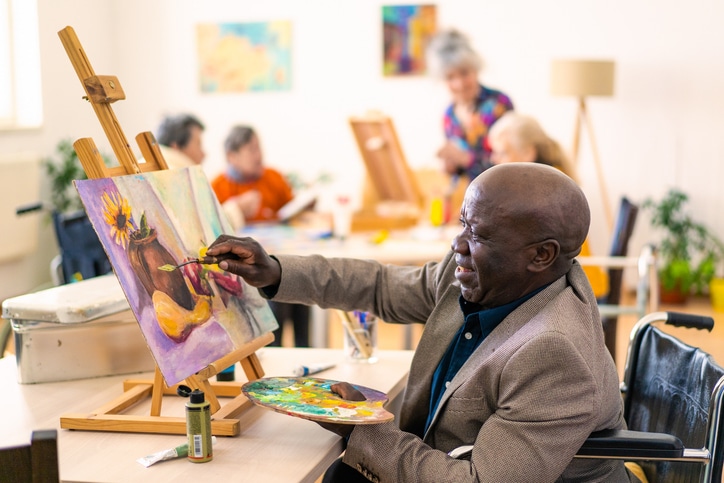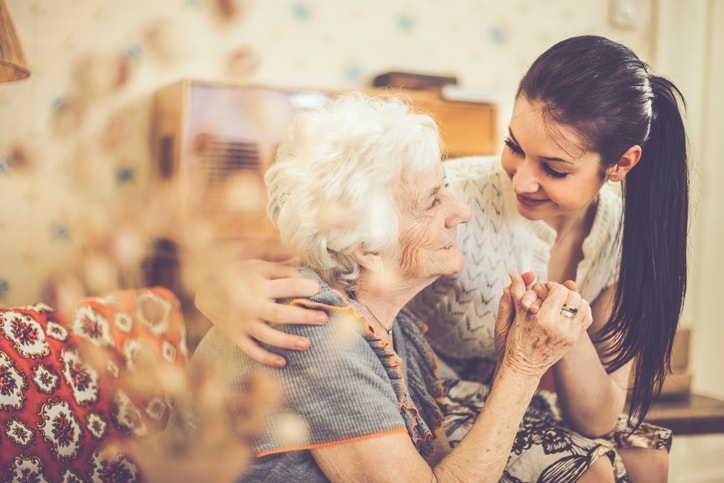Similar to starting a new job, moving into an assisted living facility can be a big life transition. Fortunately, many older adults discover assisted living can provide an increase in care and safety as well as a sense of belonging and renewed sense of purpose. Thoughtful and diverse enrichment assisted living activities can build relationships and promote both health and happiness.
Jen Larochelle-Starbuck, the assisted living activities director at 10 Wilmington Place in Dayton, Ohio, says she works to create experiences “that evoke all the senses and fulfill her residents’ needs for love, belonging, a sense of purpose and community.”
Key takeaways
- Moving into assisted living can be a major life transition, but thoughtfully designed activities help residents feel connected, purposeful, and fulfilled through opportunities for care, safety and community.
- Enrichment activities in assisted living — ranging from exercise and mindfulness to creative arts and educational workshops—support seniors’ physical health, mental sharpness and emotional well-being.
- When activities are varied, personalized and inclusive, they foster companionship, prevent isolation, and empower residents to rediscover joy and purpose in daily life.
Why are assisted living activities important?
Activities in assisted living communities help seniors stay physically active, mentally sharp and socially connected. Research conducted by the National Institute on Aging supports that engagement activities can prevent feelings of isolation and depression. And participating in activities and games later in life can reduce an older adult’s risk of dementia, according to another study.
Jay Mikosch, campus executive director of Wellington Bay in Wellington, Florida, agrees, noting that one of the major benefits of enrichment activities at assisted living is companionship and the opportunity for group interaction.
What are good assisted living activities?
No two communities are the same, but many assisted living communities work to provide enrichment activities that are collaborative and fun while helping to maintain residents’ cognitive and physical health. And they may tailor activities based on residents’ interests and preferences, which increases chances for engagement.
Mikosch says he works closely with his team to ensure residents have daily access to captivating activities ranging from chair yoga, crafts and drum circles to athletic events such as the Senior Olympics or Wisdom Warrior Challenges, which test their knowledge in various categories.
Kat O’Brien the assisted living lifestyle director for Clearwater at South Bay in Torrance, California says her activity calendar is centered around “whole-person wellness” activities, which aim to be physically active, social engaging, mentally-stimulating, environmental, purpose-driven as well as meaningful and nourishing for seniors’ minds and bodies.
Here’s a quick look at different types of assisted living activities:
Educational, creative and skill-building activities
Mentally-stimulating activities allow residents to learn something new, gain skills or build upon knowledge they acquired long ago.
Mikosch stresses the importance of having a variety of activities for residents to choose from to maintain interest and engagement. “Life enrichment pursuits change and evolve because interests change and evolve,” he adds.
Education, creative and skill-building activities include:
- Storytelling workshops
- Technology workshops, which could cover a variety of subjects such as how to use smartphones or FaceTime to online safety
- Academic lectures and informational presentations
- Book clubs
- Guest speakers
- Poetry readings
- Foreign language classes
- Baking
- Knitting/crocheting
- Arts and crafts, such as painting, pottery, woodworking, silk scarf making and rubber block printing
Experiences [should] “evoke all the senses and fulfill residents’ needs for love, belonging, a sense of purpose and community.”
— Jen Larochelle-Starbuck, assisted living activities director
Physical fitness and mindfulness
Movement and mindfulness-based activities at assisted living communities allow residents to stay physically active and encourage coordination as well as bonding to create fun and memorable experiences.
Larochelle-Starbuck says one of the activities that her residents who have varied levels of abilities enjoy is called Noodle Ball. “We play upbeat music that they love, blow up large balloons and have them hit the balloons with colorful pool noodles,” explains Larochelle-Starbuck.
Other examples of physical or mindfulness activities:
- Dance classes (ballroom, line, square, swing)
- Golf tournaments
- Aerobics
- Swimming
- Water aerobics
- Bocce ball
- Shuffleboard
- Seated Pilates
- Chair yoga
- Tai chi
- Meditation
Entertainment and social events
The experts we spoke to agree that the goal for entertainment and social activities is to encourage residents to try new things while honoring the things that previously gave them joy.
Examples of entertainment and social events include:
- Live performances (stand-up comedy, music, magic and drama troupes)
- Interactive events (trivia nights, karaoke singing contests)
- Movie nights
- Holiday celebrations
- Carnivals
- Senior proms
- Art and fashion shows
- Pool parties
- Happy hours (with or without alcoholic drinks)
Games and cognitive activities
Engaging indoor activities for seniors can also provide cognitive benefits that keep residents mentally sharp.
Examples of games and cognitive activities include:
- Traditional games like Bingo, card games (think Bridge, Canasta, Rummy), Chess, Checkers
- Puzzle games like sudoku, word searches and crossword puzzles
- Video games, such as interactive Wii Sports like bowling or tennis
- App games like Candy Crush or Words with Friends
- Nerf gun target shooting
- Jigsaw puzzles
Outdoor and nature-based activities
Getting outdoors and engaging with nature at whatever degree available can also provide a great way for seniors to feel connected and find purpose.
Mimi Nguyen, activities director of Double Creek, an assisted living and memory care community in Round Rock, Texas, says her community participates in a Green Thumbs Club where they grow different flowers and vegetables and maintain a small garden. “My goal is to make these exercises, outings and activities accessible for all of our older adult residents who need varying levels of care or live with dementia/Alzheimer’s,” says Nguyen.
Examples of nature-based activities:
- Birdwatching
- Visits from and to the local nature center
- Planting flowers, herbs and vegetables from seeds
- Tending to the raised flower beds
- Outdoor picnic
- Nature walks
- Garden tours
Excursions and cultural events
Beyond organizing opportunities to commune together in nature, going out on excursions away from an assisted living residence can broaden seniors’ horizons. “We frequently encourage residents to get a change of scenery through planned excursions such as lighthouse trips, whale watching, scenic drives, farmer’s markets and car shows,” says O’Brien.
Some other examples include:
- Concerts
- Museum trips
- Sporting events
- Theater performances
- Church services
- Bookstore events
- Community service projects
A final word on activities for seniors in assisted living
Activities at assisted living facilities can span across several categories, be adjusted for those with limited mobility and benefit the minds, bodies and spirits of their residents. When residents have input in deciding and have plenty of options, senior living activities can evolve and change as much as they need them to.
Ultimately, activities at assisted living facilities go way beyond passing the time for residents, according to the experts we spoke to.
As Larochelle-Starbuck concludes, “It’s about meeting their needs, fostering relationships and giving residents a sense of purpose again.”





